@keithj01 In case you missed it - https://www.diyaudio.com/community/...ortion-measurement.402566/page-9#post-7558653
Go back a few posts for the test setup detail, oh here - https://www.diyaudio.com/community/...ortion-measurement.402566/page-8#post-7557454
Go back a few posts for the test setup detail, oh here - https://www.diyaudio.com/community/...ortion-measurement.402566/page-8#post-7557454
Yes, a couple of observations - odd harmonics are much more attenuated than even harmonics (implying a reduction in symmetrical non-linearity, asymmetrical not so much), and bass frequencies seem relatively unaffected (which anyway are less important subjectively).
Both are I'm sure clues to the source of the distortion...
Both are I'm sure clues to the source of the distortion...
Yes. Drivers, speakers, playback systems have various sources for the harmonic distortion. Likely all harmonics are generated in various distribution in all of them, but what we measure acoustically is combination off them all. If series resistor seems to drop 3rd harmonic mostly, then most of 3rd harmonic was originating from electrical domain, from driver motor. If 2nd harmonic didn't drop, it's likely originating from mechanical / acoustic domain, like from suspension non-linearity, air in the box, stuff like that, and dominates over 2nd harmonic generated in the motor. Thus, didn't see much drop as resistor doesn't have effect in acoustic domain.
See few posts in previous thread, from which hörnli offshoot this one: https://www.diyaudio.com/community/threads/drive-current-distortion-measurement.402566/post-7556054
See few posts in previous thread, from which hörnli offshoot this one: https://www.diyaudio.com/community/threads/drive-current-distortion-measurement.402566/post-7556054
Last edited:
Well, Bl(x) seems unlikely, as it would be mostly a low frequency problem. And BL(i) seems unlikely, as I'd expect that to result in asymmetry and therefore even-order distortion products.
When you have a strongly 3rd harmonic dominant distortion, my experience is it is almost always magnetic saturation. For instance I was testing an amplifier I designed and I couldn't figure out why I had more distortion than expected. It was almost a pure 3rd harmonic. Eventually I realized that I had used a steel capacitor lead to connect an output terminal block to a copper alligator clip. I seem to remember it was something on the order of 0.004% THD at 100W into 4ohms.
If you look at the distortion of the TC9FD (one of the speakers in my 20 ohm measurements) as level increases:
https://hificompass.com/en/speakers/measurements/peerless/peerless-tc9fd18-08
You will see that the 3rd harmonic almost doesn't change at all as the 2nd harmonic passes by. This is because saturation causes a disturbance proportional to the signal level every time the current crosses zero. It is like a soft form of crossover distortion.
You are unlikely to create a clean 3rd harmonic which doesn't rise with SPL by any other mechanism in a speaker.
If you look at the distortion of the TC9FD (one of the speakers in my 20 ohm measurements) as level increases:
https://hificompass.com/en/speakers/measurements/peerless/peerless-tc9fd18-08
You will see that the 3rd harmonic almost doesn't change at all as the 2nd harmonic passes by. This is because saturation causes a disturbance proportional to the signal level every time the current crosses zero. It is like a soft form of crossover distortion.
You are unlikely to create a clean 3rd harmonic which doesn't rise with SPL by any other mechanism in a speaker.
ventually I realized that I had used a steel capacitor lead to connect an output terminal block to a copper alligator clip.
So is GR Research somewhat right about those steel nuts on binding posts?
They DO cause distortion, the question is just how much, and is it audible. I've been meaning to measure it at some point but I just don't use any steel in my speaker connections. Also you have to consider the voicecoil in most speakers is wound around a big slug of steel. Would the nut be audible if the pole piece isn't? It really depends on the saturation curve of the steel nut I guess.
Well, I did some measurements to check on that, and this is uncanny. I was not able to measure ANY distortion from a steel nut, from a binding post, that stuck to a magnet. So to confirm my sanity I found a capacitor with steel leads and tried that again. The capacitor lead causes distortion but the binding post nut does not...
This is the same amp I used for the current drive distortion measurements. X axis is watts into the 8ohm load.
THD 1KHz vs power into 8ohms:
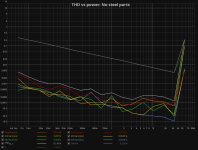
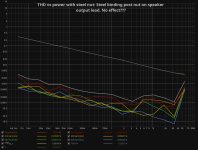
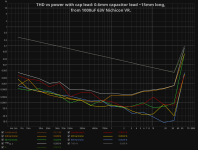
THD vs frequency at 29W:
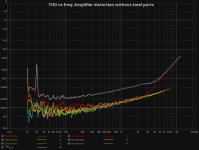
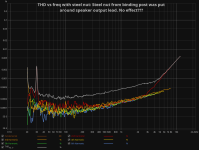
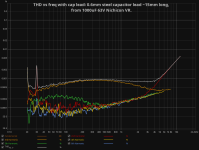
Notice that the 3rd harmonic for the capacitor lead starts to fall above 400Hz and the 5th harmonic vanishes into nothing. I suspect this is because the harmonic frequencies reach the point where skin effect begins to attenuate them.
All these measurements are far below the levels of distortion from speakers I showed earlier in this thread.
This is the same amp I used for the current drive distortion measurements. X axis is watts into the 8ohm load.
THD 1KHz vs power into 8ohms:



THD vs frequency at 29W:



Notice that the 3rd harmonic for the capacitor lead starts to fall above 400Hz and the 5th harmonic vanishes into nothing. I suspect this is because the harmonic frequencies reach the point where skin effect begins to attenuate them.
All these measurements are far below the levels of distortion from speakers I showed earlier in this thread.
Last edited:
Interesting measurement Kean.
Woul;d it be possible that in the cap it is not the steel wire itself that causes the distortion, but the connection/welding of the steel wire to the cap material?
Jan
Woul;d it be possible that in the cap it is not the steel wire itself that causes the distortion, but the connection/welding of the steel wire to the cap material?
Jan
JUST the capacitor lead was tested, no signal was going through the capacitor.
Things seem to get complicated fast when you start passing signal through steel. I was able to measure some distortion (rising with frequency) if I passed the signal into one side of the nut and out the other, but not if I put the nut on a wire. And it was intermittent (one of my measurements had a 2nd harmonic). I could adjust the position of the alligator clips on the nut and it would be gone. I was able to measure a larger 3rd harmonic when passing through a grey steel screwdriver, but constant with frequency so it can't be a magnetic effect.
I think there are nonlinear ohmic effects when you are actually passing current into steel. The current density is high at the contact points and so the flux density will also be high, along with possible thermal effects. There could be oxides with semiconductor like effects, there can be thermal modulation at the contact points along with flux modulation.
What I'm getting from these experiments is that you should never pass current into steel, but otherwise the distortion is unmeasurable for steel nuts (at least up to 30W/8ohm). Personally I just avoid it. I know the RF world is well aware of harmonic generation from steel hardware.
Things seem to get complicated fast when you start passing signal through steel. I was able to measure some distortion (rising with frequency) if I passed the signal into one side of the nut and out the other, but not if I put the nut on a wire. And it was intermittent (one of my measurements had a 2nd harmonic). I could adjust the position of the alligator clips on the nut and it would be gone. I was able to measure a larger 3rd harmonic when passing through a grey steel screwdriver, but constant with frequency so it can't be a magnetic effect.
I think there are nonlinear ohmic effects when you are actually passing current into steel. The current density is high at the contact points and so the flux density will also be high, along with possible thermal effects. There could be oxides with semiconductor like effects, there can be thermal modulation at the contact points along with flux modulation.
What I'm getting from these experiments is that you should never pass current into steel, but otherwise the distortion is unmeasurable for steel nuts (at least up to 30W/8ohm). Personally I just avoid it. I know the RF world is well aware of harmonic generation from steel hardware.
Do you think the magnetic field strength is high enough here to cause Barkhausen noise ?
Regards
Charles
Regards
Charles
No!I could do the measurements again, but they would show the same result.
https://www.diyaudio.com/community/...surements-with-rew.338511/page-3#post-5812663
Not if you do it with stepped sine!
https://www.diyaudio.com/community/...ortion-measurement.402566/page-9#post-7558031
https://www.diyaudio.com/community/...ortion-measurement.402566/page-9#post-7558653
Please also read the postings in between ;-)
Best regards
Bernd
Last edited:
I do this all the time for amps. I might have time to do it eventually. What frequency do you think is most relevant?
- Home
- Loudspeakers
- Multi-Way
- LRDDMC Loudspeaker Resistor Drive Distortion Measurement Challenge